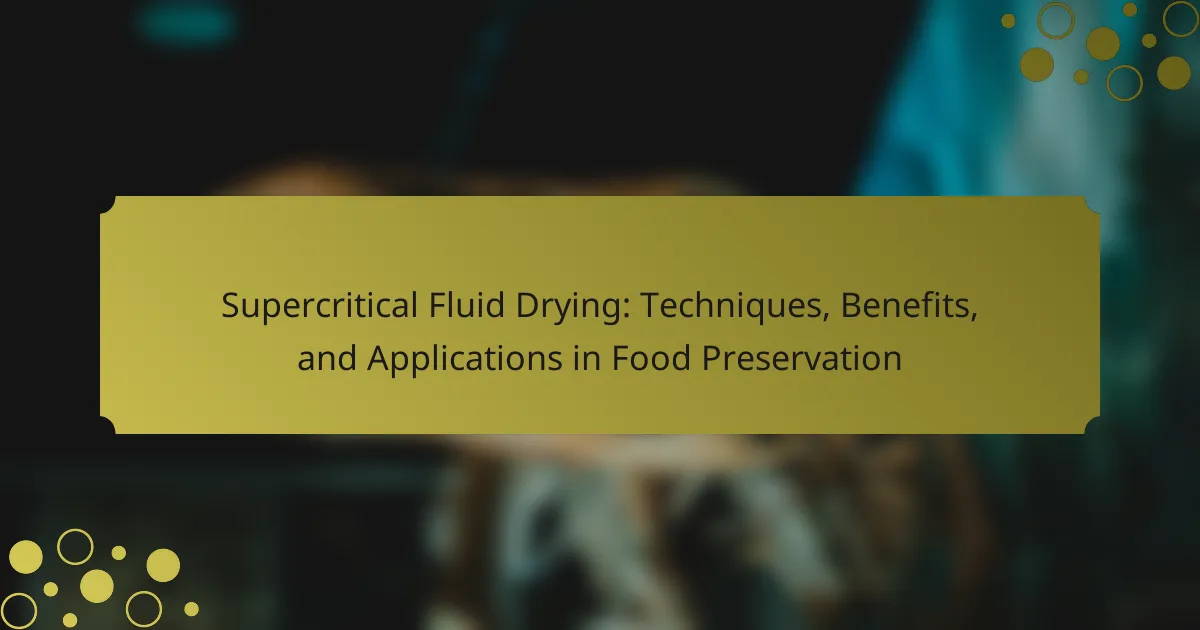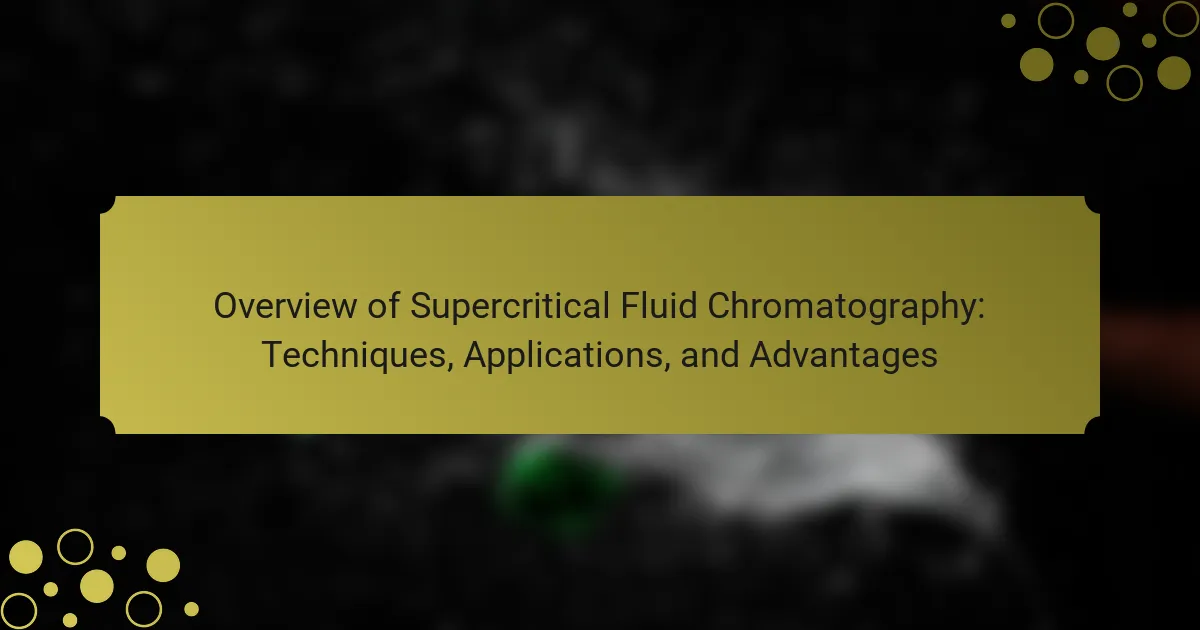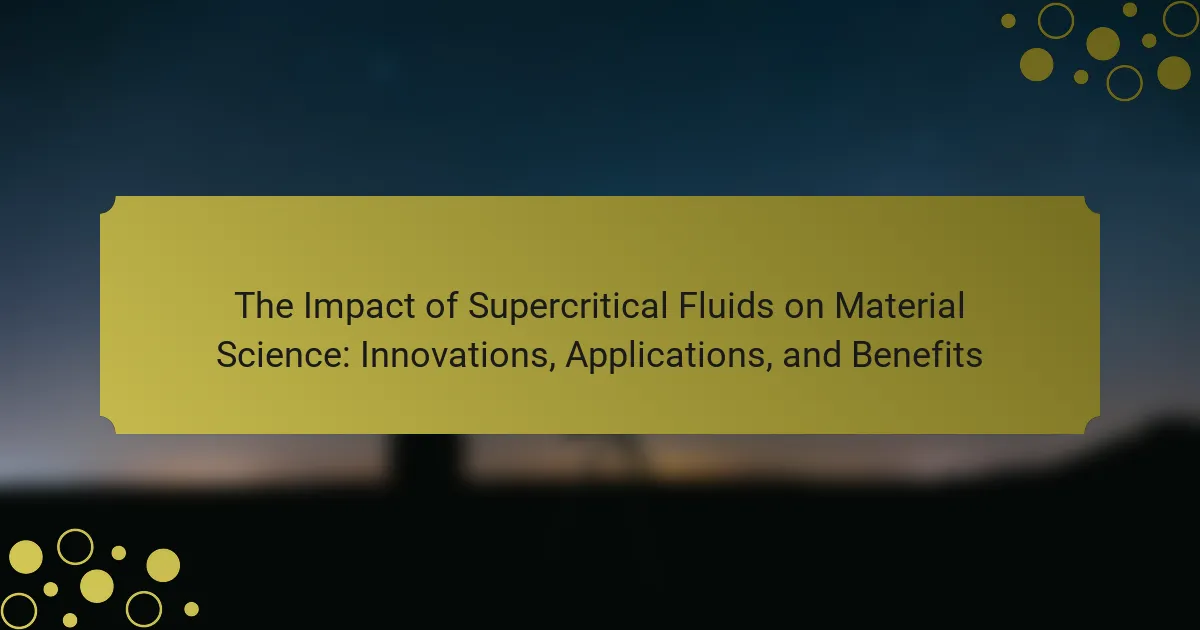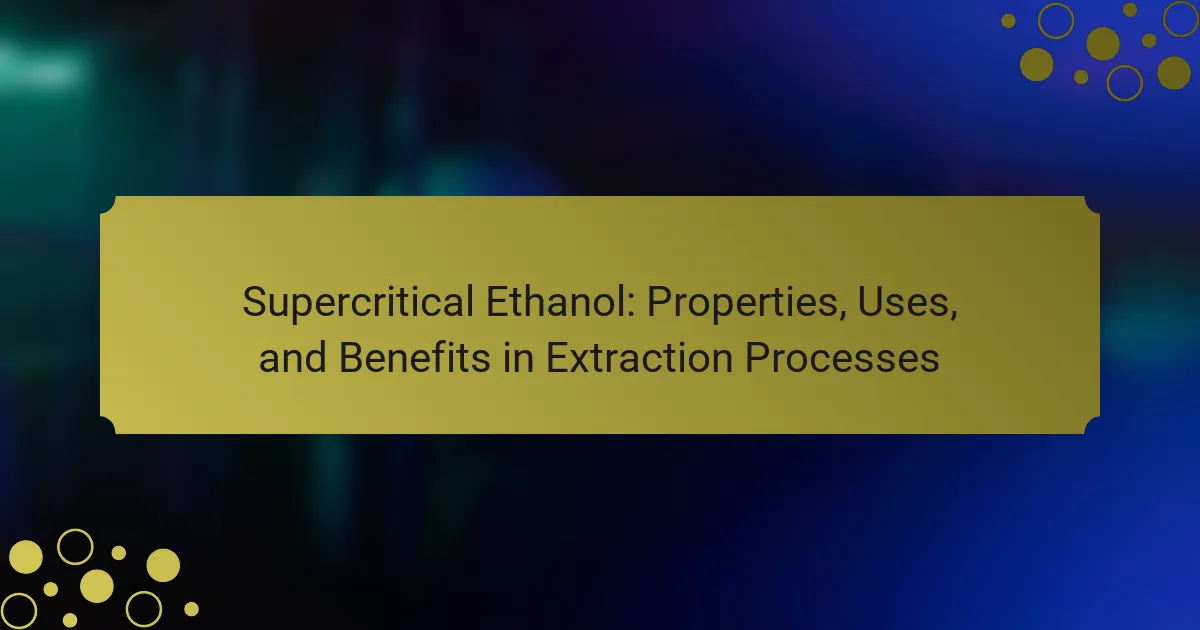Supercritical CO2 extraction is a method that utilizes carbon dioxide in a supercritical state to efficiently extract compounds from various materials, including essential oils, flavors, and pharmaceuticals. This extraction technique is recognized for its ability to selectively isolate desired compounds while maintaining the integrity of heat-sensitive substances and minimizing environmental impact. The process operates at lower temperatures, reducing thermal degradation risks, and produces high-purity extracts without harmful solvent residues. Supercritical CO2 extraction is widely applied across multiple industries, including food, pharmaceuticals, cosmetics, and biofuels, demonstrating its versatility and effectiveness in obtaining high-quality botanical extracts and active ingredients.
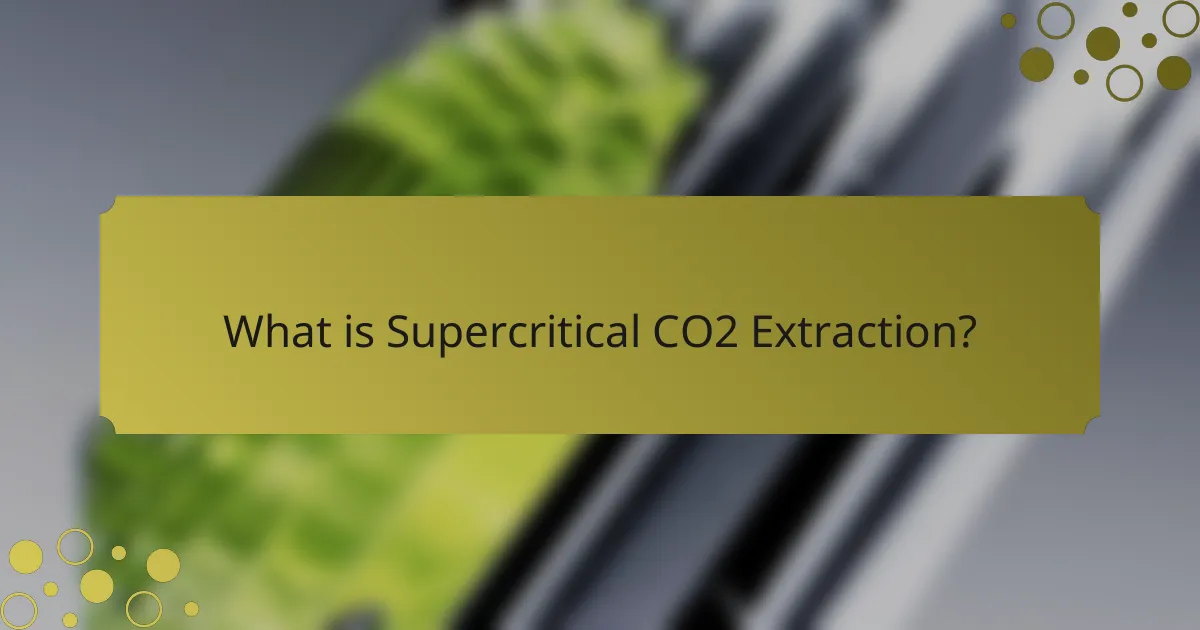
What is Supercritical CO2 Extraction?
Supercritical CO2 extraction is a method that uses carbon dioxide in a supercritical state to extract compounds from various materials. In this state, CO2 exhibits properties of both a gas and a liquid, allowing it to penetrate materials effectively. This process is widely used in the extraction of essential oils, flavors, and pharmaceuticals. The supercritical CO2 can selectively extract desired compounds while leaving behind unwanted materials. This method is favored for its efficiency and environmentally friendly nature. It operates at relatively low temperatures, preserving the integrity of heat-sensitive compounds. Supercritical CO2 extraction is recognized for producing high-purity extracts without harmful solvents.
How does Supercritical CO2 Extraction work?
Supercritical CO2 extraction works by utilizing carbon dioxide in a supercritical state to extract compounds from various materials. In this process, carbon dioxide is subjected to high pressure and temperature, transforming it into a supercritical fluid. This supercritical CO2 exhibits properties of both a gas and a liquid, allowing it to penetrate materials effectively.
The supercritical CO2 selectively dissolves desired compounds, such as essential oils or cannabinoids, while leaving behind unwanted materials. After extraction, the pressure is reduced, causing the CO2 to revert to a gas and separate from the extracted compounds. This method is highly efficient and preserves the integrity of the extracted substances.
Research indicates that supercritical CO2 extraction is employed in industries like food, pharmaceuticals, and cosmetics due to its effectiveness and eco-friendliness.
What are the key characteristics of supercritical CO2?
Supercritical CO2 is a state of carbon dioxide that occurs above its critical temperature and pressure. In this state, CO2 exhibits unique properties that are distinct from its gaseous and liquid forms. It has a density similar to that of a liquid while maintaining the viscosity of a gas. This allows it to diffuse through solids and liquids effectively. Supercritical CO2 is non-toxic and environmentally friendly, making it suitable for various applications. It can dissolve a wide range of non-polar compounds, which is beneficial for extraction processes. Additionally, supercritical CO2 can be easily converted back to gas, leaving no residue in the extracted product. These characteristics make supercritical CO2 an ideal solvent for applications in food, pharmaceuticals, and cosmetics.
What is the process involved in Supercritical CO2 Extraction?
Supercritical CO2 extraction involves using carbon dioxide in a supercritical state to extract compounds from materials. The process begins by pressurizing CO2 until it reaches a supercritical state, where it exhibits properties of both a gas and a liquid. This supercritical CO2 is then passed through the plant material, dissolving desirable compounds. The mixture is then depressurized, allowing the CO2 to return to a gaseous state and separate from the extracted compounds. This method is efficient and preserves the integrity of sensitive compounds. It is widely used in industries such as food, cosmetics, and pharmaceuticals.
What are the advantages of using Supercritical CO2 Extraction?
Supercritical CO2 extraction offers several advantages. It is a highly efficient method for extracting essential oils and active compounds. This technique uses carbon dioxide in a supercritical state, which allows for precise control over temperature and pressure. The process is environmentally friendly, as it does not involve harmful solvents. Supercritical CO2 is non-toxic and leaves no residue, ensuring purity in the final product. Additionally, it can selectively extract specific compounds, enhancing the quality of the extract. This method also allows for scalability, making it suitable for both small and large production. Overall, supercritical CO2 extraction provides a safe, efficient, and versatile solution for various applications.
How does Supercritical CO2 Extraction compare to other extraction methods?
Supercritical CO2 extraction is more efficient and environmentally friendly compared to traditional methods like solvent extraction or steam distillation. It uses carbon dioxide in a supercritical state to extract compounds without leaving harmful residues. This method yields higher purity and quality of extracts. Additionally, supercritical CO2 extraction allows for precise control over temperature and pressure, optimizing the extraction process. In contrast, solvent extraction can introduce impurities and requires extensive purification. Steam distillation may degrade heat-sensitive compounds. Studies show that supercritical CO2 extraction can extract a wider range of compounds effectively, making it a preferred choice in various industries.
What environmental benefits does Supercritical CO2 Extraction provide?
Supercritical CO2 extraction provides significant environmental benefits by reducing the need for harmful solvents. This method utilizes carbon dioxide in a supercritical state, which is non-toxic and environmentally friendly. It minimizes chemical waste, as CO2 is easily recycled in the process. Supercritical CO2 extraction also lowers energy consumption compared to traditional extraction methods. According to research, it can achieve similar or better yields while using less energy. Additionally, this method produces fewer greenhouse gas emissions, contributing to a lower carbon footprint. Overall, supercritical CO2 extraction promotes sustainable practices in various industries.
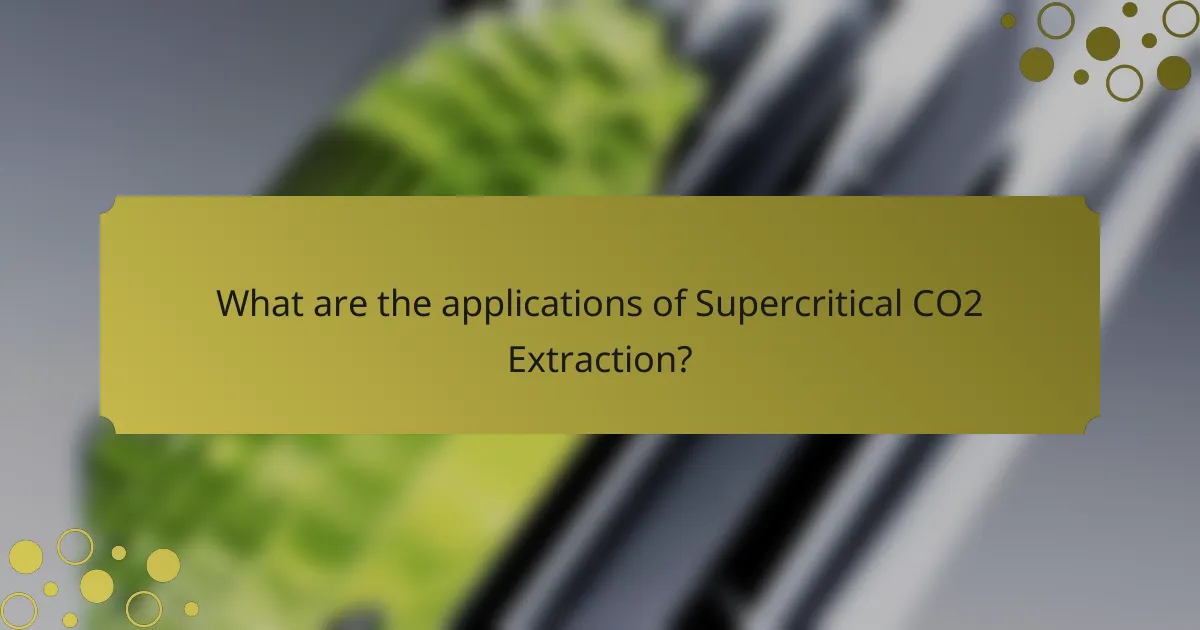
What are the applications of Supercritical CO2 Extraction?
Supercritical CO2 extraction is used in various industries for its efficiency and effectiveness. It is commonly applied in the food industry to extract flavors, aromas, and essential oils from natural products. This method is also utilized in the pharmaceutical industry for extracting active ingredients from plants. Additionally, supercritical CO2 extraction is employed in the cosmetic industry to obtain high-quality botanical extracts. The process is favored for its ability to produce pure and potent extracts without harmful solvents. Furthermore, it is used in the extraction of biofuels and in environmental applications to clean up pollutants. The versatility of supercritical CO2 extraction makes it a valuable technique across multiple sectors.
In which industries is Supercritical CO2 Extraction commonly used?
Supercritical CO2 extraction is commonly used in the food and beverage, cosmetics, and pharmaceuticals industries. In the food and beverage sector, it extracts flavors, fragrances, and essential oils without leaving harmful residues. The cosmetics industry utilizes it to obtain high-purity botanical extracts for skin care products. In pharmaceuticals, supercritical CO2 extraction is applied to isolate active compounds for drug formulation. This method is favored for its efficiency and ability to maintain product integrity across these industries.
How is Supercritical CO2 Extraction applied in the food industry?
Supercritical CO2 extraction is applied in the food industry to extract flavors, aromas, and nutrients from natural products. This method utilizes carbon dioxide in a supercritical state, which acts as a solvent. The process is efficient and preserves the integrity of sensitive compounds. It is commonly used to extract essential oils from herbs and spices. Additionally, supercritical CO2 extraction is employed to produce high-quality coffee and tea. This technique results in a clean end product without harmful residues. Research indicates that it can enhance the extraction yield compared to traditional methods. Studies show that supercritical CO2 extraction maintains the flavor profile and nutritional value of the extracted materials.
What role does Supercritical CO2 Extraction play in the pharmaceutical sector?
Supercritical CO2 extraction plays a crucial role in the pharmaceutical sector by efficiently extracting active compounds from raw materials. This method utilizes carbon dioxide in a supercritical state, combining properties of both liquid and gas. It allows for precise extraction of phytochemicals, essential oils, and other bioactive substances. Supercritical CO2 extraction is non-toxic and environmentally friendly, making it suitable for pharmaceutical applications. The process preserves the integrity of sensitive compounds, ensuring high-quality extracts. Studies show that this method can yield higher purity and yield compared to traditional extraction techniques. Furthermore, it minimizes the use of harmful solvents, aligning with safety regulations in the pharmaceutical industry.
What products are derived from Supercritical CO2 Extraction?
Supercritical CO2 extraction produces various products, primarily essential oils, botanical extracts, and natural flavors. This method is widely used in the food, cosmetic, and pharmaceutical industries. Essential oils derived from plants retain their aroma and therapeutic properties. Botanical extracts include compounds like CBD oil from hemp. Natural flavors extracted using this technique are often used in food products. The process is favored for its ability to produce high-purity extracts without harmful solvents. Additionally, supercritical CO2 extraction is efficient and environmentally friendly. It allows for the extraction of delicate compounds that might be damaged by heat or traditional extraction methods.
What are the most common essential oils extracted using Supercritical CO2?
The most common essential oils extracted using Supercritical CO2 include lavender, peppermint, and rosemary. Lavender oil is known for its calming properties and is widely used in aromatherapy. Peppermint oil is popular for its invigorating scent and is often used in personal care products. Rosemary oil is valued for its potential cognitive benefits and culinary uses. These oils are extracted using Supercritical CO2 due to the method’s ability to preserve the delicate compounds found in plants. This extraction technique results in high-quality oils that retain their natural aroma and therapeutic properties.
How does Supercritical CO2 Extraction contribute to the production of natural flavors?
Supercritical CO2 extraction contributes to the production of natural flavors by efficiently isolating volatile compounds from raw materials. This method uses carbon dioxide in a supercritical state, which possesses properties of both gas and liquid. The supercritical CO2 acts as a solvent, selectively dissolving flavor compounds while leaving behind unwanted substances. This results in high-purity extracts that retain the original flavor profile of the source material. Studies show that supercritical CO2 extraction can produce flavors with enhanced aroma and taste compared to traditional methods. Additionally, this extraction technique is environmentally friendly, as it avoids the use of harmful solvents. The ability to fine-tune extraction parameters allows for the customization of flavor profiles, catering to specific industry needs.
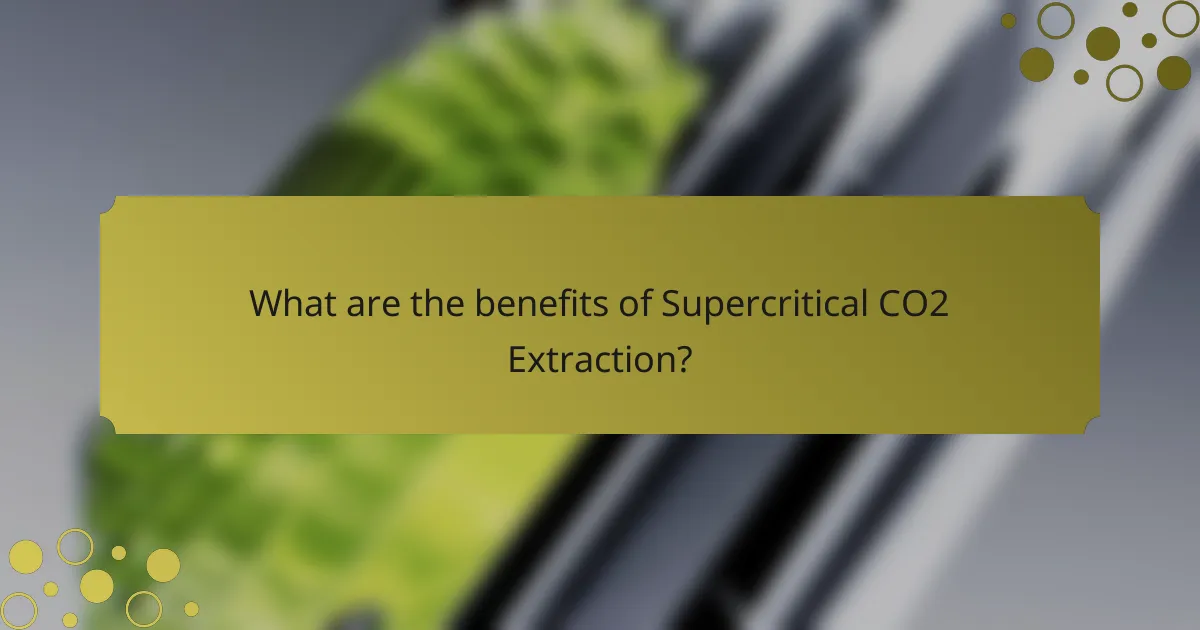
What are the benefits of Supercritical CO2 Extraction?
Supercritical CO2 extraction offers several key benefits. It is a highly efficient method for extracting essential oils and compounds. This technique preserves the integrity of sensitive compounds. It operates at lower temperatures compared to traditional methods. This reduces the risk of thermal degradation. Supercritical CO2 extraction is also environmentally friendly. It uses carbon dioxide, which is non-toxic and recyclable. Additionally, it leaves no solvent residues in the final product. This method allows for selective extraction of desired compounds, enhancing product quality.
Why is Supercritical CO2 Extraction considered a safe method?
Supercritical CO2 extraction is considered a safe method due to its non-toxic nature. It uses carbon dioxide, which is generally recognized as safe (GRAS) by the FDA. This method does not leave harmful residues in the extracted products. Additionally, supercritical CO2 operates at low temperatures, preserving the integrity of sensitive compounds. The process also minimizes the risk of combustion since CO2 is not flammable. Furthermore, it allows for precise control over extraction conditions, enhancing safety during production. These factors contribute to its reputation as a safe extraction technique in various industries.
What health benefits are associated with products extracted using Supercritical CO2?
Products extracted using Supercritical CO2 offer several health benefits. They are known for retaining essential nutrients and bioactive compounds. This extraction method minimizes the presence of harmful solvents. It results in pure, high-quality extracts. Supercritical CO2 extraction preserves the integrity of sensitive compounds. Research shows that these extracts can enhance the bioavailability of nutrients. Additionally, they may possess antioxidant properties. Studies indicate that such extracts can support overall health and wellness.
How does the purity of extracted compounds affect their efficacy?
The purity of extracted compounds significantly influences their efficacy. High purity levels ensure that the active ingredients are concentrated, providing maximum therapeutic effects. Impurities can dilute the effects and introduce unwanted side effects. For instance, in medicinal applications, pure extracts have been shown to yield better bioactivity. A study published in the Journal of Natural Products demonstrated that pure compounds exhibited higher antioxidant activity compared to their impure counterparts. Therefore, maintaining high purity in extraction processes is crucial for achieving desired outcomes in applications.
What are the cost considerations of implementing Supercritical CO2 Extraction?
The cost considerations of implementing Supercritical CO2 Extraction include equipment, operational, and maintenance expenses. Equipment costs can range from $100,000 to over $1 million, depending on the scale and complexity of the system. Operational costs involve energy consumption, which can be significant due to high-pressure requirements. Additionally, the cost of CO2 as a solvent must be factored in, although it is generally less expensive than organic solvents in the long run. Maintenance costs are also important, as regular servicing is required to ensure safety and efficiency. The total cost of ownership should be evaluated to understand the long-term financial implications.
How does the initial investment compare to long-term savings?
The initial investment in supercritical CO2 extraction equipment is typically high. This equipment can range from $100,000 to over $1 million depending on capacity and technology. However, long-term savings can be significant. Supercritical CO2 extraction is efficient and reduces the need for solvents, which cuts operational costs. Studies show that companies can save 30-50% on production costs over time. Additionally, the process yields higher quality products, leading to increased market value. Thus, while the upfront costs are substantial, the long-term savings and benefits often outweigh the initial investment.
What factors influence the operational costs of Supercritical CO2 Extraction?
The operational costs of Supercritical CO2 Extraction are influenced by several key factors. Equipment costs are significant, as high-quality extraction systems can be expensive. The cost of CO2 itself also impacts overall expenses. Energy consumption during the extraction process contributes to operational costs, as it requires substantial power. Labor costs are another factor, as skilled technicians are needed for operation and maintenance. Additionally, the scale of production affects costs; larger operations may benefit from economies of scale. The complexity of the extraction process can also influence costs, with more intricate methods generally being more expensive. Finally, regulatory compliance and safety measures can impose additional costs on operations.
What best practices should be followed for effective Supercritical CO2 Extraction?
To achieve effective Supercritical CO2 Extraction, maintain optimal temperature and pressure settings. The extraction process should typically occur between 31°C and 90°C. Pressure levels should range from 1000 psi to 5000 psi for enhanced solubility. Use high-quality CO2 to ensure purity in the final product. Regularly monitor the extraction parameters to ensure consistency and quality. Implement proper equipment maintenance to prevent contamination. Conduct trials to determine the best extraction time for specific materials. Utilize co-solvents when necessary to improve extraction efficiency. These practices enhance yield and product quality, aligning with industry standards.
Supercritical CO2 extraction is a method that utilizes carbon dioxide in a supercritical state to efficiently extract compounds from various materials, particularly in the food, pharmaceutical, and cosmetic industries. This process is recognized for its ability to produce high-purity extracts without harmful solvents, operating at low temperatures to preserve sensitive compounds. The article explores the mechanics of supercritical CO2 extraction, its advantages over traditional methods, its environmental benefits, and its diverse applications across multiple sectors. Key characteristics, operational costs, and best practices for effective extraction are also discussed, providing a comprehensive overview of this extraction technique.
